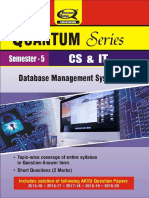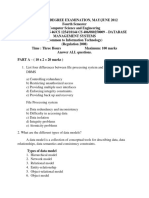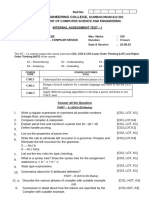qb - database practices
Uploaded by
parvathyqb - database practices
Uploaded by
parvathyARASU ENGINEERING COLLEGE, KUMBAKONAM-612 501
DEPARTMENT OF COMPUTER SCIENCE & ENGINEERING
Sub. Code & Name : CP4152 & Database practices
Year/Sem./Branch : I/I/ME-CSE Regulation: 2021 Academic Year: 2024-2025
Staff Name : Mrs. S.PARVATHY
QUESTION BANK
UNIT – I
RELATIONAL MODEL
PART – A
1. What do you mean by weak entity set?
2. List any four applications where a database is used?
3. Define database management system.
4. List out the different types of attributes in ER data model.
5. Distinguish between super key and candidate key.
6. What is dynamic SQL?
7. Define embedded SQL.
8. Define data model.
9. Define ER model.
10. Write a note on data consistency.
11. State the difference between primary key and unique key.
12. List the responsibilities of DB manager.
13. Define key and distinguish between super key and candidate key.
14. What is first normal form?
15. What are the two ways to use functional dependencies?
16. Define BCNF.
17. Define third normal form.
18. Why functional dependencies are called trivial functional dependencies?
19. Define fourth normal form.
20. Write the complete set of relational algebra operations.
21. What is denormalization?
22. Compare embedded SQL with dynamic SQL.
23. Compare network and relational data models.
PART – B
1. Explain the database system architecture with neat diagram.
2. Discuss about various data model in database.
3. Explain in detail about basic structure of SQL with example.
4. Explain relational algebra with example.
5. Explain the different types of database languages.
6. Discuss about E-R model with an example.
7. Explain the BCNF and 3NF with your own example. Also give how it differs from that of 3NF.
8. Explain about decomposition using multi-valued dependencies.
9. Discuss in detail about Fifth normal form.
10. Explain in detail about functional dependency theory with suitable examples.
11. Illustrate the algorithm for decomposition.
12. Elaborate the concept of languages in data manipulation.
13. Write the concept of creating, altering, viewing and dropping techniques in DDL.
14. Compute the closure (F+) of the following set functional dependencies for the relational
schema R=(A,B,C,D,E) and F={A->BC->E,B->D,E->A}. list the candidate keys for R.
15. Explain the 2NF, 3NF and BCNF normal forms with examples.
16. Write a program to create and manipulate a student database using embedded SQL.
17. Draw an E-R diagram for a small banking database, assuming your own data requirements.
UNIT – II
DISTRIBUTED DATABASES, ACTIVE DATABASES AND OPEN DATABASE
CONNECTIVITY
PART – A
1. Define distributed database.
2. Write about distributed query processing.
3. Write the advantages of distributed databases.
4. What is homogeneous distributed database?
5. What is trigger?
6. When triggers are used?
7. List the types of triggers.
8. What is meant by distributed transaction?
9. State the purpose of open database connectivity.
10. What are the four different types of distributed database systems?
11. What is active databases?
12. Which are three parts of a trigger?
13. What is the use of active database?
14. What are the rules of an active database system?
15. What is database connectivity?
16. What is database connectivity with mySQL?
17. What are the steps required to access data from a table in a database?
18. How to access a relational database using python?
19. What is mySQL db?
20. Specify the ACID properties.
PART – B
1. Explain the idea about data storage in distributed system.
2. Write in detail about open database connectivity.
3. What area design and implementation issues for active database.
4. Discuss about transaction management in distributed database.
5. Explain the use of trigger with your own example.
6. What is a view? How can it be created? Explain with an example/.
7. Explain briefly about the working of two phase locking protocol using a sample transaction.
8. i) Explain about immediate update and deferred update recovery techniques.
ii) Explain the need for concurrency with illustration.
9. Describe the transaction recovery, system recovery and media recovery.
10. Explain about immediate update and deferred update recovery techniques.
11. Elaborate distributed database architecture.
12. Write in detail about distributed query processing.
13. Describe how to access a relational database using PHP.
14. Discuss in detail about to access a relational database using python.
15. Discuss in detail how to perform transactions?
16. Elaborate how to access a relational database using R.
17. Explain distributed deadlock, deadlock prevention and deadlock avoidance.
UNIT –III
XML DATABASES
PART – A
1. Define XML schema.
2. What is meant by unstructured data?
3. Define DTD.
4. What is meant by XPath?
5. Give an example for structure of XML.
6. Differentiate structured and semi structured xml data.
7. What is xml namespace?
8. Define XML query languages.
9. What is native XML database?
10. What are the various features of XML?
11. What is XML schema?
12. What are the various types available in XML schema?
13. Define XLINK.
14. List out the three parts of XSL.
15. List out the type of DTD.
PART – B
1. How XML are processed and stored in web database. Explain in detail.
2. Explain in detail about XML documents and DTD.
3. Elaborate the concept of XML schema.
4. Discuss about XML querying and its types.
5. Write detailed notes on XML hierarchical data model.
6. Explain in detail about XML document schema with suitable examples.
7. Explain about XML and example for XML representation of banking information.
8. Explain XML databases with an example.
UNIT –IV
NOSQL DATABASES AND BIG DATA STORAGE SYSTEMS
PART – A
1. What is meant by NoSQL?
2. List the characteristics of MongoDB.
3. What are the features of NoSQL?
4. Compare NoSQL and RDBMS.
5. How does NoSQL DB budget memory?
6. What are the two types of data model in MongoDB?
7. Does NoSQL database interact with oracle database?
8. What is the difference between NoSQL and MySQL DBs?
9. When should use a NoSQL database instead of a relational database?
10. What is CAP theorem? How is it applicable to NoSQL systems?
11. What do you understand by polyglot persistence in NoSQL?
12. Enlist the differences between SQL and NoSQL.
13. What is MongoDB?
14. Why MongoDB is called a document based database?
15. What is the difference between MongoDB database and document?
16. What is a storage engine in MongoDB?
17. What is replication in MongoDB?
18. Is MongoDB a distributed system?
19. How MongoDB is different from RDBMS?
20. What is key-value store in NoSQL?
21. What are three operations performed on a key-value store?
22. What is DynamoDB?
23. What are the key features of DynamoDB?
24. What are indexes and secondary indexes in DynamoDB?
25. Is Voldemort a distributed key-value storage system?
26. What are the three major components of HBase?
27. What data model does HBase use?
28. What is the role of ZooKeeper in HBase?
29. What is HBase storage and distributed system concepts?
30. What is the difference between NoSQL and GraphDB database?
31. What is a key feature of the Neo4j NoSQL solution?
PART – B
1. Explain in detail about big data.
2. Discuss about categories of NoSQL systems.
3. Describe the CAP theorem.
4. Write simple queries to access databases created using MongoDB.
5. Explain in detail Hbase Crud operations.
6. Explain in detail MapReduce.
7. Discuss in detail about Hadoop.
8. Write simple queries to access databases created using DynamoDB.
9. Explain cipher query language of Neo4j.
10. Discuss in detail Hbase storage and distributed system concepts.
11. Explain NoSQL graph databases and Neo4j.
12. Discuss in detail MongoDB data model.
UNIT –V
DATABASE SECURITY
PART – A
1. Define flow control.
2. Define encryption and public key.
3. What are the five database security levels?
4. Why is database security is important?
5. What are the main components of database security?
6. What is DDoS attacks?
7. What is database security model?
8. What are granting and revoking previleges?
9. What is the concept of discretionary access privileges?
10. What are the types of database security?
11. What are the control measures of database security?
12. What is sensitivity of data?
13. What is the relationship between information security versus information privacy?
14. What are the two restrictions are enforced on data access based on the subject/object
classifications?
15. What are the challenges in database security?
16. What is data integrity and why it is important?
17. What is database survivability?
18. What are the three key elements of data privacy?
19. How can we preserve data privacy?
20. What is mandatory access control?
PART – B
1. Elaborate SQL injection.
2. Write about the challenges to maintaining database security.
3. Discuss about the various security issues faced by the database.
4. Illustrate granting and revoking privileges with example.
5. Explain in detail flow control.
6. Explain statistical database security.
7. Discuss in detail about specifying the limits on propagation of privileges?
8. Discuss in detail encryption and public key infrastructures.
9. Describe the challenges to maintaining database security.
10. Explain oracle label based security.
11. Discuss database survivability.
You might also like
- Cs2255-Database Management Systems: Qbank For Unit - INo ratings yetCs2255-Database Management Systems: Qbank For Unit - I5 pages
- @vtucode - in DBMS Question Bank 2021 SchemeNo ratings yet@vtucode - in DBMS Question Bank 2021 Scheme5 pages
- Cs2255-Database Management Systems: Question Bank Unit - INo ratings yetCs2255-Database Management Systems: Question Bank Unit - I4 pages
- ADBMS Imp Question Bank By MCA SCHOLARS GroupNo ratings yetADBMS Imp Question Bank By MCA SCHOLARS Group1 page
- CS3492 Database Management Systems Two Mark Questions 1No ratings yetCS3492 Database Management Systems Two Mark Questions 143 pages
- NEW REVSIED SYALLBUS Academic Year 2019-20 Fybsc (CS) Dbms-1 Chapter 1 Introduction of DBMS (No. of Lectures 4)No ratings yetNEW REVSIED SYALLBUS Academic Year 2019-20 Fybsc (CS) Dbms-1 Chapter 1 Introduction of DBMS (No. of Lectures 4)5 pages
- 702418225 CP4152 Database Practices Unit 1 2No ratings yet702418225 CP4152 Database Practices Unit 1 273 pages
- Kings: Department of Computer Science & Engineering Question BankNo ratings yetKings: Department of Computer Science & Engineering Question Bank5 pages
- DATABASE MANAGEMENT SYSTEM-DBMS-question-bankNo ratings yetDATABASE MANAGEMENT SYSTEM-DBMS-question-bank44 pages
- 702418225 Cp4152 Database Practices Unit 1 2No ratings yet702418225 Cp4152 Database Practices Unit 1 272 pages
- Planning Processes - Project Management ExerciseNo ratings yetPlanning Processes - Project Management Exercise4 pages
- Topic Based Vocabulary List (Chinese - English) : Zebra BānmăNo ratings yetTopic Based Vocabulary List (Chinese - English) : Zebra Bānmă4 pages
- Write Affirmative Sentences in The Correct Word OrderNo ratings yetWrite Affirmative Sentences in The Correct Word Order2 pages
- Age of Revolutions Summative Unit ProjectNo ratings yetAge of Revolutions Summative Unit Project4 pages
- salesforce.com-Salesforces Agentforce Is Here Trusted Autonomous AI Agents to Scale Your WorkforceNo ratings yetsalesforce.com-Salesforces Agentforce Is Here Trusted Autonomous AI Agents to Scale Your Workforce14 pages
- Scaffolding Techniques For English Language Learners - Part 1 - Collaborative ClassroomNo ratings yetScaffolding Techniques For English Language Learners - Part 1 - Collaborative Classroom2 pages
- Herpderp1909 Dragons Reworked Part IV - Dragon Hall of FameNo ratings yetHerpderp1909 Dragons Reworked Part IV - Dragon Hall of Fame55 pages
- Cs2255-Database Management Systems: Qbank For Unit - ICs2255-Database Management Systems: Qbank For Unit - I
- Cs2255-Database Management Systems: Question Bank Unit - ICs2255-Database Management Systems: Question Bank Unit - I
- CS3492 Database Management Systems Two Mark Questions 1CS3492 Database Management Systems Two Mark Questions 1
- NEW REVSIED SYALLBUS Academic Year 2019-20 Fybsc (CS) Dbms-1 Chapter 1 Introduction of DBMS (No. of Lectures 4)NEW REVSIED SYALLBUS Academic Year 2019-20 Fybsc (CS) Dbms-1 Chapter 1 Introduction of DBMS (No. of Lectures 4)
- Kings: Department of Computer Science & Engineering Question BankKings: Department of Computer Science & Engineering Question Bank
- Topic Based Vocabulary List (Chinese - English) : Zebra BānmăTopic Based Vocabulary List (Chinese - English) : Zebra Bānmă
- Write Affirmative Sentences in The Correct Word OrderWrite Affirmative Sentences in The Correct Word Order
- salesforce.com-Salesforces Agentforce Is Here Trusted Autonomous AI Agents to Scale Your Workforcesalesforce.com-Salesforces Agentforce Is Here Trusted Autonomous AI Agents to Scale Your Workforce
- Scaffolding Techniques For English Language Learners - Part 1 - Collaborative ClassroomScaffolding Techniques For English Language Learners - Part 1 - Collaborative Classroom
- Herpderp1909 Dragons Reworked Part IV - Dragon Hall of FameHerpderp1909 Dragons Reworked Part IV - Dragon Hall of Fame
































































































